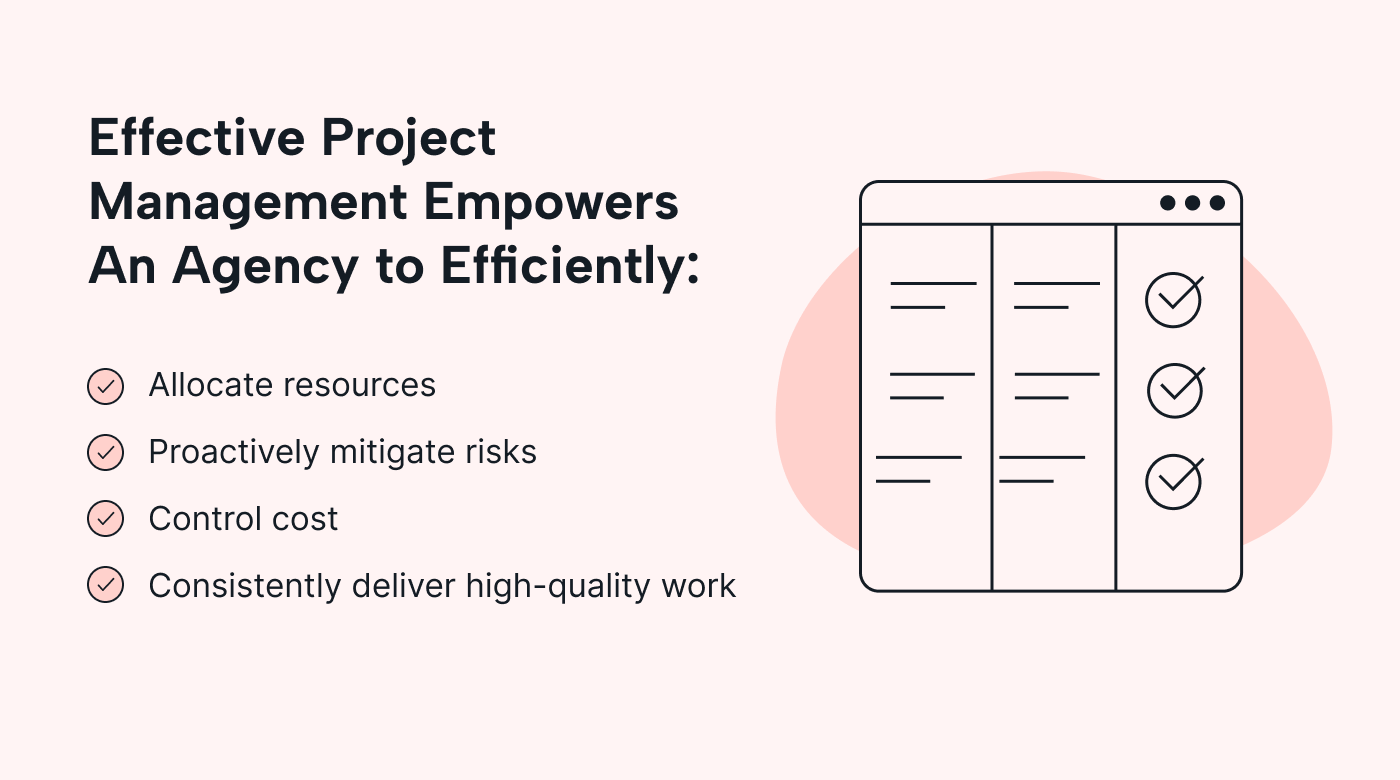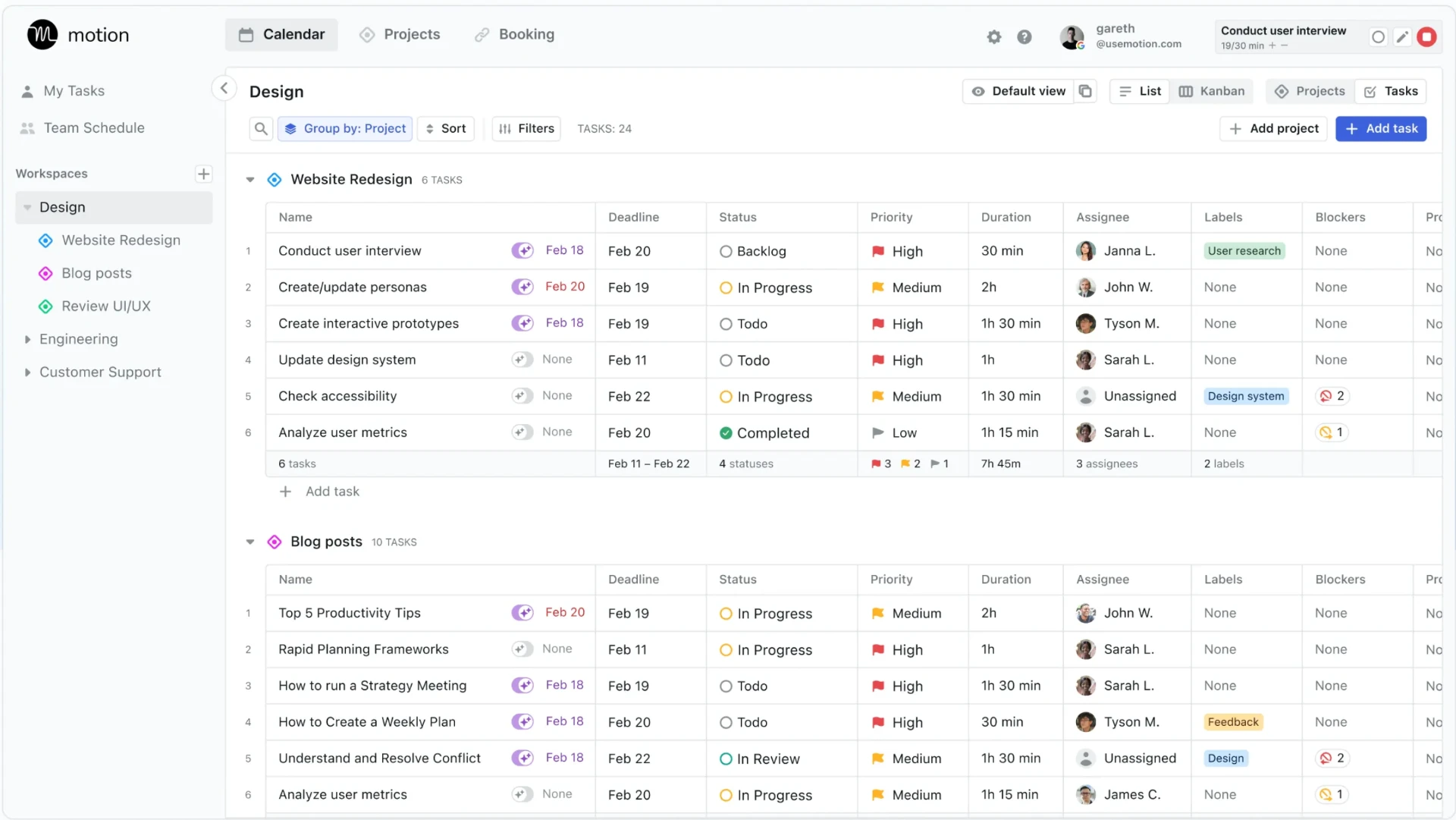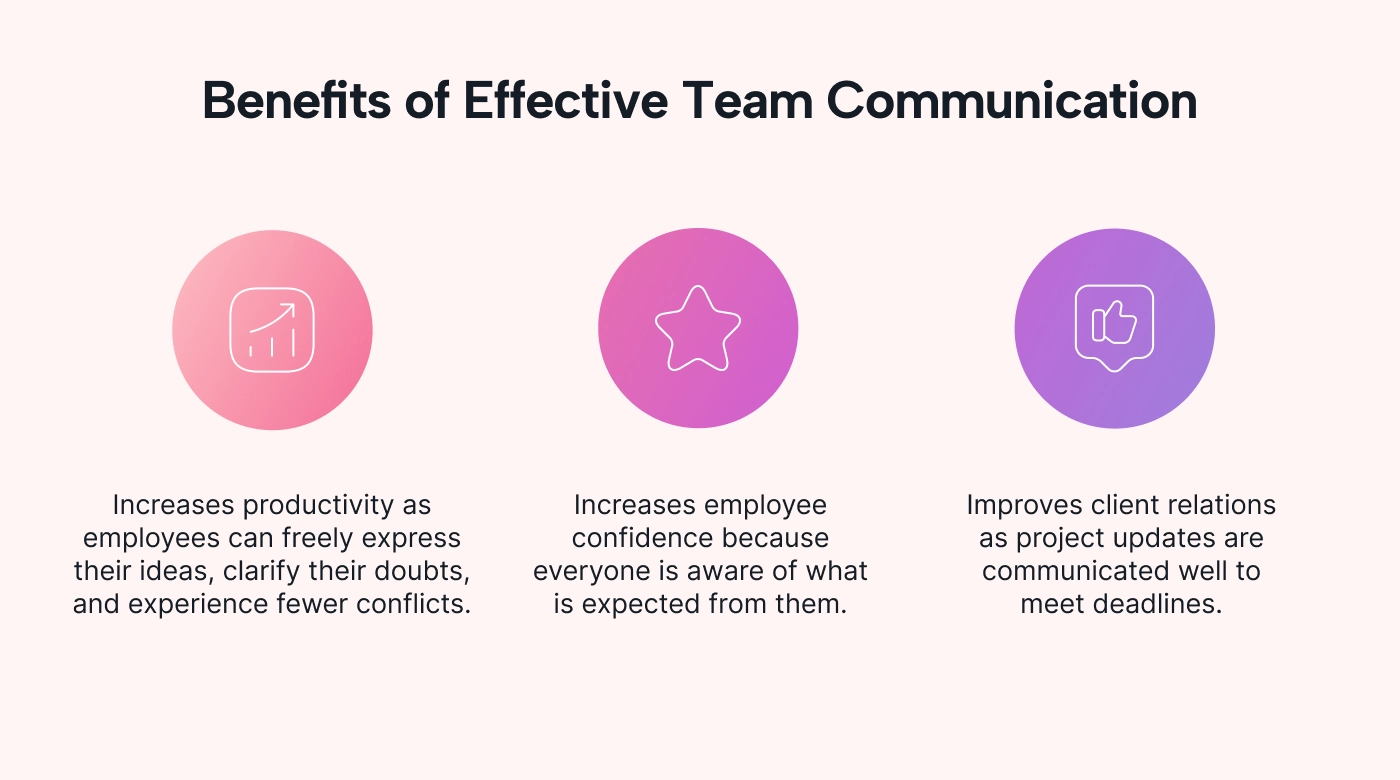Agency life is not for everyone.
A big reason for that is the fact that clients expect high-quality work, with a fast turnaround time, for far less money than a full-time team member would cost.
This leads to a high-stress environment.
One of the best ways to ensure success as an agency is by utilizing and customizing a project management solution.
Without a well-oiled project management system, agencies risk descending into chaos, jeopardizing client relationships, plummeting team morale, and ultimately, tanking profitability.
As someone who has worked in three high-performing agencies, and alongside some agency operations experts, I’m excited to help you define your agency project management process!
If you're in a hurry, here's a quick TL;DR:
- Agency project management is crucial for the success of your agency, impacting client relationships, resource allocation, and project timelines.
- Implementing strategies like choosing the right methodology, designing SOPs, defining project scope, and tracking KPIs is essential for successful project management.
- Hiring a project manager, ensuring effective team collaboration, and using project management software like Motion can streamline agency project management processes.
- Clear communication, resource allocation, risk management, and stakeholder engagement are key components of effective agency project management.
- With the right tools and strategies in place, agency project management can be efficient, productive, and lead to client satisfaction.
What is agency project management?
Agency project management is the systems and processes you use to manage all your agency projects from initiation to completion.
Let’s take a quick peek into the tasks that fall under agency project management:
- Selecting the tool your agency will use for project management
- Designing workflows that help manage agency projects and tasks
- Training your team on how to use the tools and workflows you create
- Managing your project team’s time and billable hours
- Onboarding and communicating with your client
The importance of agency project management
Effective agency project management is more than just a nice-to-have; it's a strategic imperative that can make or break an agency's success.
Here are some key reasons why agency project management is so crucial:
- Client satisfaction and retention: Client satisfaction is necessary for success. Effective project management ensures that deliverables meet client expectations, deadlines are met, and communication channels remain open throughout the project lifecycle. This fosters trust, builds lasting relationships, and ultimately leads to client retention and repeat and referral business.
- Keeping margins high: Margins are key to high profitability. According to Scoro, Anything lower than a 50% gross margin will likely create financial problems for your company. This is a huge reason why creating a project management process is so imperative for agencies. If you spend too much time and resources on deliverables, they’ll start to cost more than they are worth.
- Resource optimization: Agencies operate with finite resources, both in terms of human capital and budgets. Effective project management allows for optimal resource allocation, ensuring that the right people with the right skills are assigned to the right tasks at the right time. This maximizes productivity, minimizes waste, and contributes to overall profitability.
- Risk mitigation: Every project carries inherent risks, from scope creep to resource constraints and unexpected roadblocks. Effective project management involves identifying potential risks early on and implementing strategies to mitigate or eliminate them before they escalate into larger issues.
- Continuous improvement: By documenting processes, capturing lessons learned, and analyzing project metrics, agencies can continuously refine and improve their project management practices. This fosters a culture of continuous learning and adaptation, ensuring that the agency remains agile and competitive in a rapidly evolving market.

How to successfully manage projects in an agency
You’ll need solid agency project management strategies to consistently churn out successful projects, especially to avoid disappointing your clients.
1. Decide on a project management software for your agency
While starting with a project management tool might seem like a later stage process, it’s actually very important to do this early on.
This is simply because once you select your tool, you can create processes and templates that are built for the tool itself.
When selecting project management software, you want to ensure you choose a tool that meets your budget needs, can grow with you, is easy to use, and works with your existing systems and processes.
Similarly, when selecting an agency project management tool, dig into its features. Does the tool have:
- Project progress tracking: Can the tool showcase multiple views, such as Kanban boards, task views, project views, calendar views, timeline views, and Gantt charts?
- Task management: Does the tool allow task assignment, dependencies, priorities, and detailed instruction?
- Automation: Does the tool support automatic scheduling, time tracking, dependency adjustments, prioritization, and more? Does it use AI effectively?
- Documentation: Does the tool enable you to create or attach documents to meetings or tasks?
- Integrations: Can the tool work inside the tools you use each and every day?
- Customizations: Is the tool more of a cookie-cutter solution that works for multiple industries and roles? Or can it be shifted to fit your independent needs?
- Ability to Replace Multiple Tools: Can the tool replace one or more tools that your team is already using? How can it help you decrease your tech costs in the long run?
I’ll cut to the chase here and let you know that my favorite project management tool by far is Motion.
After using Asana for several years, I recently made the switch to Motion because I believe no other tool can accurately depict and understand team and individual capacity.
Here are some Motion features you don’t want to miss:
- Time-integrated task management: Every task has a time component, allowing you to schedule work directly on your calendar or agenda view. This solves issues around timing uncertainty and lack of transparency in traditional project management tools.
- Automated scheduling: Motion's AI automatically schedules tasks based on priorities, durations, and deadlines, eliminating the need for manual coordination and planning. This empowers project managers to make faster decisions.
- Capacity planning: Get visibility into team bandwidth and whether deadlines can be met with current resources. No more guesswork around delivery timelines.
- Workflow automation: Motion allows you to set up automated workflows for repeatable processes, assigning tasks with the appropriate durations to team members as needed.
2. Determine the roles that will be in charge of project tracking and completion
This is totally dependent on the size of your agency, but having accountability plans in place for who does what concerning your project management needs is crucial.
And it exceeds far past just tracking and completion (though those two are the most important.)
You also need someone who helps select the tool, develops processes, and trains team members.
Additionally, you need to make sure this person has the capacity to do so.
Some ways we’ve seen this work broken out
- An operations Lead
- Customer / client success managers
- Account managers
- Marketing coordinators
- Project managers
Of course, having a dedicated project manager is ideal, but not always possible for smaller agencies.
If this isn’t something you can accommodate, we recommend ensuring there is always someone not responsible for deliverables reviewing projects and completion times.
This person ideally should be in somewhat of a leadership role in order to hold people accountable.
3. Design SOPs, and templates for tasks, projects, and/or workspaces
A standard operating procedure (SOP) is a collection of step-by-step instructions designed by an organization to help employees do assigned routine activities.
It typically contains details like managing scope, budget, quality, and risks.
You can create SOPs for every type of agency project and reuse them—saving time and effort.
SOPs are just one element of the equation, though. Once you determine your project management software, you’ll also want to create assets like templates for projects, tasks, etc.
In Motion, for example, we suggest creating task and project templates.
Task templates are a perfect solution for work that you do repeatedly.
So a task template for a blog might look like this…
- Task Name
- Client Name
- Due Date
- Assignee
- Priority-Level
- Duration
- Keyword
- Phase in Funnel
- CTA
- Light Outline
- Links to Resources
Motion recently launch project workflow templates, which take this to an entirely new level. Check it out 👇
4. Train team members
Ensuring your team is trained on and properly utilizing a new tool is probably one of the most challenging aspects of agency project management.
And just because you start requiring the use of a tool, does not mean your team members will actively adopt it.
In fact, according to a study by Wrike, “28% of teams with ten or more team members give up on using their project management tool after one year.”
This means it is IMPERATIVE for you as a leader to take training and adoption on a new tool very seriously.
Some quick tips on how to do this well include…
- Ask your project management tool team for support. Often they will come to team meetings or have extensive training resources available that your team can utilize.
- Provide training resources with notes, and timestamps for important tasks. Make completing these trainings as easy, and as resourceful as possible. That way, if someone tasks the training while using the tool, they can easily search for a timestamp like “how do I add a priority-level to a task” and find what they need.
- Introduce one new space at a time. For example, start with tasks, and move on to projects in phase two.
- Determine a set day for each week where team members should be dedicating time to their training
- Make space for them to complete their weekly training. Remove or reallocate tasks to ensure they can complete the training within their working hours
- Raise up team members who are using the product well, early on, and offer incentives like gift cards or bonuses
- Use the software for EVERYTHING if and when possible. Team notes, 1:1 notes, time-off requests, etc.
5. Assign out work in a way that doesn’t burn out team members, or underutilize resources
As your team grows and gets busier, being tactful about assigning out work becomes even more important.
If you have one role that does a similar type of work (i.e. content writing) you can start following your top team members, identifying what a successful week or month looks like for them, and then replicating their process.
So, for example, let’s say writing ten blog posts a month when someone is fully in office and ramped up is the best case scenario, then you’ll want to ensure all your writers are assigned the proper amount of articles, not more, not less.
And of course, you’ll want to account for any upcoming time off, and plan for any sick time or delays as well.
To do something like this, you really need to rely on your project management tool, so it can help you visualize capacity across all teams.
This is actually one of my favorite Motion features.
Motion intimately understands my team and my own capacity accurately by combining our calendars and tasks into one place.

Additionally, when I assign tasks to my fellow teammates, I simply need to add a due date, expected duration, and priority level, and Motion will intelligently select a time and date for them to complete the task.
It also alerts me if someone is at or over capacity, or if there is a blocker that is not allowing my task to be completed.
6. Ensure effective and clear team and client collaboration
On-going communication regarding project status and expectations needs to be as clear as possible. Here are some strategies to help encourage effective team collaboration:
- Implement stand-up meetings: A stand-up meeting is a short, daily, meeting to discuss progress and identify blockers. They are usually only 15 minutes long, and allow team members the opportunity to speak with their fellow collaborators and leaders about any updates or delays.
- Communicate inside your tools: At least 72 hours in advance, comment on an important task and ask collaborators if they expect an on-time delivery. It can feel a bit like overkill at first, but requiring teams to communicate inside your project tracking tools is a must to ensure no updates are lost, and everyone is held accountable.
- Create views for each team member and client: Ensure that all team leads can easily access their team's productivity in one click. Leaders should be using these views for 1:1s, team meetings, and stand-ups, to ensure they have a full picture of what’s expected of them.
- Send weekly production updates to clients: Work with collaborators to connect on client deliverables and updates. Ensure clients are well aware in advance if a slight delay must occur, and why.

7. Mitigate risks
Risk management in agency project management involves spotting potential risks and brainstorming strategies to prevent them from becoming full-blown disasters.
Let’s discover some risks you may face using a website agency example:
- Scope creep - Adding features not initially requested in the scope is sometimes called “gold plating,” which requires money, human resources, time, and testing.
- Resource constraints - Developers might get sick, go on vacation, or leave in the middle of a project.
- Endless rounds of client feedback - This can delay website development and add to agency costs.
- Changing priorities - can disturb the workflow, and resources may need reshuffling.
- Hiring process - It takes time to hire specialists and ramp them up.
So, how do you manage risks in agency projects?
The best place to start is by creating clear and detailed contracts with your clients and by creating a client onboarding process that lets them know how you work best.
This can fix issues like scope creep, changes in priorities, and endless rounds of client feedback, quickly.
A way to mitigate personnel challenges is by having a bench of freelance help that can always back you up in a pinch.
To do this, you MUST have very clearly documented style guides, easy-to-access resources, and clear expectations on what is expected.
8. Track project KPIs
Tracking team performance is the best way to know whether your team is doing its best and how well you’re meeting clients’ expectations.
How you’re performing against these metrics will also reveal areas for improvement.
Here are some types of KPIs your agency can track:
- Financial metrics: Keep an eye on the budget utilization and profit margins.
- Time KPIs: Luckily, a tool like Motion can help you track your team’s team within the tool. It also helps leaders compare expected times vs. actuals.
- Quality KPIs: Check in on the customer satisfaction score (CSAT), count those change requests, and keep bug tracking on your radar. Now onto how:
- Automate reporting - Let tools do the reporting heavy lifting while you focus on analyzing them and strategizing solutions as needed.
- Set clear goals - It’s only possible to track performance if your team knows what to do.
- Conduct regular check-ins - Host regular meetings to discuss and compare how far your teams are from meeting client expectations. This allows you to devise strategies to meet the same needs.
- Choose the right tools - Pick the right project or task management tool that’ll help you track your KPIs easily.
Get started with Motion for agency project management today
Throughout this entire article, it’s clear a proper project management tool is the key to ongoing success.
Motion is the project management tool I utilize for my team's needs because of its deep understanding of team capacity, and ability to replace multiple tools.
I also love its intelligent task scheduling, seamless calendar integration, and intuitive user experience which has completely changed the way I work.
Dive into the future of agency project management and start your 7-day free trial with Motion today.
Trust me, once you experience the AI magic, there’s no going back. 🚀

Alli is Content Writer and Strategist who has worked in SaaS since 2017. She’s worked with brands like BombBomb, Animalz, SupportLogic, and Copy.ai. Alli lives in Colorado with her husband, daughter, and two dogs.




